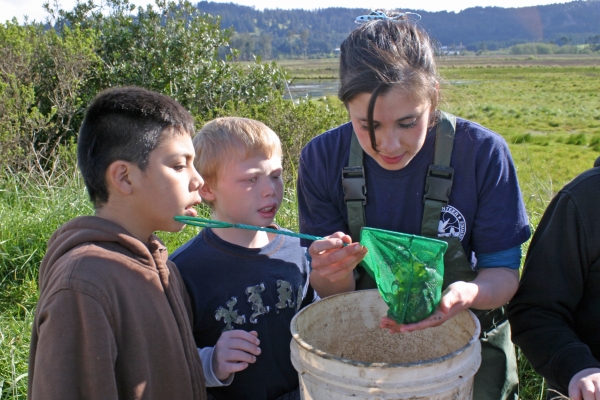
National Wildlife Refuges serve many purposes, and one of our most important roles is as outdoor classrooms. Humboldt Bay National Wildlife Refuge provides unique and exciting outdoor environments that are excellent locations for hands on learning activities.
The habitats and abundant wildlife populations around Humboldt Bay afford outstanding resources to aid in the education and discovery of the natural world. The refuge offers opportunities and guidance for outdoor class activities.
We participate in the Shorebird Sister Schools Program for 4th grade classrooms.
Please call and leave a message at 707-733-5406 Ext 1
Contact Friends of the Dunes at 707-444-1397 for more information on guided walks and field trips to the dunes.
Planning Your Field Trip – Common Questions
How many students can I bring? How many chaperones will I need?
Ideally, the refuge accommodates one class or a maximum of about 30 students at a time (accommodation for more students can be arranged with advanced notice)
An adult to student ratio of 1 adult to 5 students is required, and adult supervision is required at all times.
Do I have to make a reservation?
Yes. A minimum of two week’s advanced notice is very helpful, especially if you are requesting staff or volunteer docent assistance.
What can my group do at the Refuge?
Your group can take a self-guided walk on the 1.7 mile Shorebird Loop Trail. This level path leads through a diversity of wetland habitats where your group could see ducks, geese, shorebirds, songbirds, deer, otters and more!
You may borrow support materials from the visitor center, such as binoculars and field guides. The visitor center features informative exhibits. With advanced notice, refuge staff will be able to arrange for your group to view a short video, have an orientation talk, and/or have a guide along the Shorebird Loop Trail.
When is the best time to visit the Refuge?
There is something to see every day of the year. November through April are the best months for bird watching. In the winter, rainfall creates seasonal wetlands which attract migratory waterfowl such as ducks, geese, and swans. Aleutian cackling geese forage on the grasslands and during January, February, and March, large flocks can be seen regularly.
What facilities are available?
Restrooms are located at the visitor center. Refuge water is not potable; please have your students bring their own drinking water in water bottles. A small outdoor picnicking area is available. Bring a trash bag and pack your group’s lunch garbage home with you.
How should I prepare my group for the field trip?
Make sure that each student is dressed appropriately for the weather of the season and is wearing comfortable sturdy walking shoes.
Before you arrive, talk with your students about how they can show respect for wildlife during their visit, and review the following ecological concepts.
•Everything has a home. During your field trip, you will be walking in, around, and through several animals' living rooms, dining rooms, kitchens, bedrooms, and bathrooms. We call these homes habitats, ranges, and ecological niches. Ecology (from the Greek "oikus" which means house) is the study of the common home of all life -- the earth.
•Everything is becoming something else. All plants and animals undergo evolutionary changes and adaptations. When things die, they are broken down, decomposed, recycled, and used by other living things.
•Every living thing eats and is eaten by something else. Three categories of life forms are in the basic food cycle of life: producers, consumers, and decomposers.
•Everything depends on something else. Interaction and interdependence occur among living and nonliving things and their environment. A change in one strand of the food cycle of life affects the entire web. Nothing exists in isolation.
•Food, water, shelter, and space are the basic necessities for life. These necessities are found in the atmosphere (air), the hydrosphere (water), and the earth's crust (soil). The biosphere is the thin skin of the planet where these zones collectively support life on earth.
•Diversity is essential for life. Many similarities and differences occur among living and nonliving things. This variation is essential for maintaining a healthy community and ensuring that plants and animals survive and reproduce in spite of changing situations. Humans are capable of changing the balance of nature.


